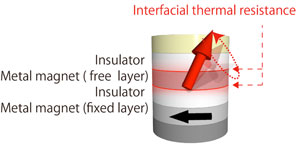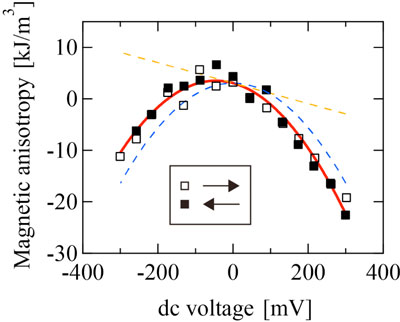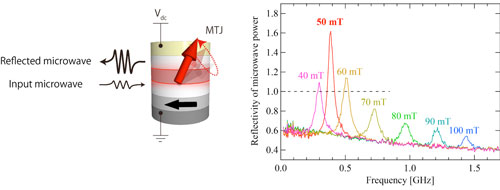| Dec 27, 2018 | |
Nano-magnets reduce energy consumption of MRAM and AI hardware(Nanowerk News) Researchers at Osaka University succeeded in efficiently controlling the direction of a nano-sized magnet by heating at high speed. The researchers also discovered that nano-magnets amplify microwave signals (Nature Nanotechnology, "Microwave amplification in a magnetic tunnel junction induced by heat-to-spin conversion at the nanoscale"). |
|
 |
|
| Fig. 1: Schematic of the double insulator MTJ. The temperature increase due to the Joule heating is enhanced by the interfacial thermal resistance at the interface between the metal magnet (free layer) and insulator because the heat dissipation is suppressed. The temperature increase changes the magnetic pole direction of the free layer (red arrow). The black arrow represents the direction of the magnetic pole of the fixed layer. (Image: Osaka University) | |
| The group’s achievements will contribute to reducing power consumption of magnetoresistive random access memory (MRAM) and artificial intelligence (AI) devices. This will make AI devices read and write to their memory more efficiently, thereby suppressing the power consumption of AI functions such as machine learning and decision making. This is another step towards achieving a super-smart society. | |
| Reducing the power consumption of information and communication devices means they could continue running for a long time, even in times of disaster. Spintronics is a widely-researched field in which MRAM technology has been developed using magnetic tunnel junctions (MTJs). MRAM uses the direction of a magnetic pole to store information, so it can retain memory without standby power. Using these technologies, researchers have tried to reduce the energy use of AI devices. | |
 |
|
| Fig. 2: DC voltage dependence of the anisotropy of the magnetic pole of the free layer. The filled and open squares represent the voltage sweep direction. The red line is the fitting of the data. The yellow and blue dashed lines represent the linear and quadratic components of the fitting, respectively. The former is the conventional voltage-induced linear magnetic anisotropy change, and the latter is the Joule heating-induced magnetic anisotropy change. (Image: Osaka University) | |
| By controlling the magnetic alignment of an MTJ by using a small current and voltage, it is possible to reduce device power consumption. Spin-transfer-torque MRAM (STT-MRAM) has been developed; however, the problem is that its voltage increases rapidly when its write speed is high, causing a great deal of power to be used. | |
| The research group at Osaka has discovered that it is possible to write information using less energy than STT-MRAM by changing the magnetic anisotropy in an MTJ via controlling the applied voltage. To make this method practical, it is necessary to increase the magnitude of voltage-controlled magnetic anisotropy. In addition to finding proper materials, other methods for changing magnetic anisotropy have been sought. | |
| The researchers succeeded in inducing a giant magnetic anisotropy change in an MTJ with double-insulator layers by Joule heating. As temperature in the metal (free) layer of an MTJ increases, magnetic anisotropy changes, so it becomes possible to change the direction of a magnetic pole. They found that the magnetic anisotropy depended on the bias voltage due to Joule heating. This shows that the temperature increase induced by Joule heating changed magnetic anisotropy. The maximum value of the voltage-controlled magnetic anisotropy (VCMA) effect was 300 fJ/Vm, which was almost the same as the reported maximum value of the fast VCMA effect. This value will increase by improving the heat system in an MTJ. | |
 |
|
| Fig. 3: Schematic of the microwave amplification (left) and magnetic field dependence of the microwave power reflectivity spectra (right). The reflected microwave is amplified by the dc voltage (Vdc) biased MTJ. In our experiment, we have obtained a microwave power reflectivity of more than 1.6 under an external magnetic field of 50 mT and frequency of 0.4 GHz. (Image: Osaka University) (click on image to enlarge) | |
| The Osaka group also found that a microwave was amplified by an MTJ using the giant magnetic anisotropy change. Microwave amplification had been previously attempted using a microwave-frequency magnetic field; however, the microwave power obtained by conventional methods was 0.005, and there was no amplification. The Osaka group achieved a microwave power reflectivity of 1.6 with a magnetic field of 50 mT and a microwave frequency of 0.4 GHz; that is, the microwave was amplified by approximately 60% compared with the input microwave. | |
| First author Minori Goto says, “Our study is the first report of microwave amplification using spintronics devices. This research will open the way to developing high-performance microwave devices. Moving forward, we anticipate that our technology will be applied to new microwave devices with high sensitivity and high output. This will also contribute to low-power-consumption technology for MRAM and AI hardware.” |
| Source: Osaka University | |
|
Subscribe to a free copy of one of our daily Nanowerk Newsletter Email Digests with a compilation of all of the day's news. |
